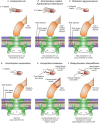Rhizobial Chemotaxis and Motility Systems at Work in the Soil
- PMID: 34512702
- PMCID: PMC8429497
- DOI: 10.3389/fpls.2021.725338
Rhizobial Chemotaxis and Motility Systems at Work in the Soil
Abstract
Bacteria navigate their way often as individual cells through their chemical and biological environment in aqueous medium or across solid surfaces. They swim when starved or in response to physical and chemical stimuli. Flagella-driven chemotaxis in bacteria has emerged as a paradigm for both signal transduction and cellular decision-making. By altering motility, bacteria swim toward nutrient-rich environments, movement modulated by their chemotaxis systems with the addition of pili for surface movement. The numbers and types of chemoreceptors reflect the bacterial niche and lifestyle, with those adapted to complex environments having diverse metabolic capabilities, encoding far more chemoreceptors in their genomes. The Alpha-proteobacteria typify the latter case, with soil bacteria such as rhizobia, endosymbionts of legume plants, where motility and chemotaxis are essential for competitive symbiosis initiation, among other processes. This review describes the current knowledge of motility and chemotaxis in six model soil bacteria: Sinorhizobium meliloti, Agrobacterium fabacearum, Rhizobium leguminosarum, Azorhizobium caulinodans, Azospirillum brasilense, and Bradyrhizobium diazoefficiens. Although motility and chemotaxis systems have a conserved core, rhizobia possess several modifications that optimize their movements in soil and root surface environments. The soil provides a unique challenge for microbial mobility, since water pathways through particles are not always continuous, especially in drier conditions. The effectiveness of symbiont inoculants in a field context relies on their mobility and dispersal through the soil, often assisted by water percolation or macroorganism movement or networks. Thus, this review summarizes the factors that make it essential to consider and test rhizobial motility and chemotaxis for any potential inoculant.
Keywords: Azospirillum brasilense; Bradyrhizobium diazoefficiens; Rhizobium leguminosarum; Sinorhizobium meliloti; chemotaxis; motility; rhizobia; soil.
Copyright © 2021 Aroney, Poole and Sánchez-Cañizares.
Conflict of interest statement
The authors declare that the research was conducted in the absence of any commercial or financial relationships that could be construed as a potential conflict of interest.
Figures



References
-
- Althabegoiti M. J., Covelli J. M., Pérez-Giménez J., Quelas J. I., Mongiardini E. J., López M. F., López-Garcia S. L., Lodeiro A. R. (2011). Analysis of the role of the two flagella of Bradyrhizobium japonicum in competition for nodulation of soybean. FEMS Microbiol. Lett. 319, 133–139. 10.1111/j.1574-6968.2011.02280.x - DOI - PubMed
-
- Atieno M., Lesueur D. (2018). Opportunities for improved legume inoculants: enhanced stress tolerance of rhizobia and benefits to agroecosystems. Symbiosis 77, 191–205. 10.1007/s13199-018-0585-9 - DOI
Publication types
LinkOut - more resources
Full Text Sources

